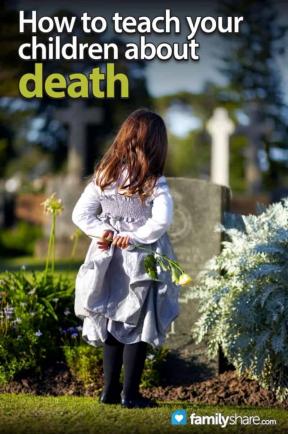
Children are going to experience the death of a loved one or friend. It's inevitable. Some sooner than others. Understanding it is vital to their being able to live life with joy and hope. Death is, after all, an important part of living. Some refer to death as passing on. When children hear this statement they may wonder what the deceased person is passing on to.
Losing a loved one to death can be frightening for children if they are not prepared for it. Some children with terminal illness are in an even far greater need to comprehend what death is. Teaching children about death can be quite simple. It's only when adults don't understand it that it becomes complicated or morbid.
Surveys show that most people believe there is life after death. So how do you explain it to children when they see the body of a loved one in a casket and recognize there is no life there? Or if they don't get that chance and yet know that person is gone, and are left wondering where he or she went, what then?
This is what we believe and how we taught our children about death and the afterlife
Start teaching early
Before losing a loved one, have a family discussion about death. Explain that it is a natural process that everyone eventually goes through. It's a kind of graduation from this life. It isn't the end, it's a new beginning. When someone graduates from high school or college that person moves on to a new life. Life is like school where we come to learn and love and experience many wonderful and sometimes hard things. When it's over we graduate and our spirit moves on to even more exciting experiences, without the pain or suffering.
Use an analogy
Boyd K. Packer gave a visual illustration of how to explain the relationship between the body and the spirit. Show your child a glove and explain that the glove is like a person's body, lifeless. Insert your hand into the glove and move it, showing motion. Explain that your hand is like the spirit that lives inside a person's body, giving it life. Then slip your hand out of the glove and explain that when people die their spirit leaves their body, but the spirit does not die. It's the real person, it's what makes the person alive. Even after death the spirit still looks like the person when he was in the body, except his spirit will be in perfect form without any deformities or disabilities.
Passing on to where?
The child may ask, "So where does the spirit go?"� When the spirit leaves the body it goes into a spirit world that many people call heaven where God lives. At this point you could have a parent leave the room and go into another room in the house, shutting the door. Ask, "Where did she go?"� Explain that she's still alive, just in another room where we can't see her right now.
Joining loved ones
. When someone dies their spirit goes to that spirit world, kind of like going into another room, where she is met by loved ones who have passed on before. Have the rest of the family go into the room where they are happily greeted by the parent there. Explain that this is how it will be when we pass on to that next life, our loved ones will greet us and it will be a happy time.
Mourning is OK
When all are back together again explain that it's OK to cry and feel sad when someone dies. That's normal because we love them and miss them. The good thing is that they are in God's care now and He will help them find happiness in that new world with Him and other loved ones.
God's comforting care
Explain that God will also care for and comfort us when we miss our departed loved one, friend or even a pet. He loves each one of us very much and wants to help us through our hard times. When we are feeling sad about those who have passed on we can pray to him and he will comfort us.
With this simple understanding about death children can face it with hope and faith, knowing that one day they will be reunited with their loved ones, never to be separated again.
More information
can be obtained in books about near-death experiences, such as Return from Tomorrow by George G. Ritchie, as well as other books on the subject, including What's On the Other Side? by Brent L. Top, and On Death and Dying by Dr. Elisabeth Kübler-Ross

